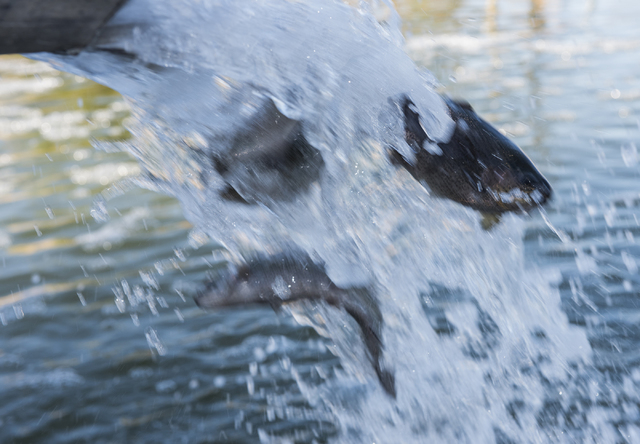Urban trout hit the road so you don’t have to
Thanks to the Nevada Department of Wildlife’s stocking program, urban anglers can easily cast their lines at conveniently located fishing holes in Las Vegas, Boulder City, Mesquite, Beatty and even Cold Creek in the Spring Mountains.
The commute is much longer and more complicated for the fish.
The ponds throughout Southern Nevada — including those at Floyd Lamb, Lorenzi and Sunset parks — are stocked with trout raised from eggs at the state-run Mason Valley Fish Hatchery near Yerington. Once the fish are big enough, state workers load them into tanks and truck them south on a delivery route that covers more than 400 miles one way and takes all day.
Blain Merrell, the hatchery’s assistant manager, made the most recent trip on Nov. 17.
He said the temperature in Mason Valley was 8 degrees when he hit the road about 7:15 a.m., after spending a little over an hour filling the truck’s tanks with water and about 6,000 fish with an average length of 9½ inches. Merrell said the rainbow trout were raised from eggs that came from a federal hatchery in Montana.
His first stop was Floyd Lamb, where he stocked the ponds and off-loaded several hundred trout into a smaller truck bound for Mesquite. From there he headed to Lorenzi, where he delivered about 900 trout by parking on the sidewalk next to the water, opening the valve on one of his tanks for a few minutes and funneling the fish into the pond through a pipe.
A few fishermen were already trying to catch the new arrivals before the last fish hit the water.
Department of Wildlife spokesman Doug Nielsen said most the trout stocked in urban ponds “end up on a fisherman’s plate,” though cormorants and other birds make off with a small share.
Merrell said a group of cormorants was waiting for him when he stopped to unload fish at Floyd Lamb.
“Two of them, it was like they knew my truck,” he said.
He is one of five hatchery employees who take turns driving the tanker, which makes 25 to 30 round-trips each year. He figures he’s made the drive at least 30 times.
The trip is so long, state transportation regulations require him to spend the night in Las Vegas before driving back.
The deliveries start when the weather cools off here in early November. Between now and March, approximately 20,000 fish a month will be trucked south from Lyon County.
“During the winter, they deal with snow and ice,” Nielsen said of the delivery drivers.
Merrell, who is from Wyoming, doesn’t really worry about winter driving conditions in Nevada. Warm weather is a bigger concern. He said they stop stocking the ponds in Southern Nevada in the spring, when the weather heats back up and the water temperature creeps toward 70.
“Then the fish roll over and die, and nobody’s happy. We get hate mail,” he said with a laugh.
Urban ponds in Southern Nevada used to be stocked with fish from the state hatchery at Lake Mead. That facility was forced to shut down in 2007, after the lake level dropped and invasive quagga mussels found their way inside.
For a few years after that, local ponds were stocked from a hatchery in Oregon, Nielsen said, “but that’s a long way to haul a trout.”
Eventually, production was expanded elsewhere in Nevada to make up for the loss of the Lake Mead hatchery.
Today, the Mason Valley hatchery produces more than 700,000 trout a year of different varieties, most of them rainbow trout. It’s a 24/7 operation that requires workers to be on call at any hour and close enough to respond within minutes in case of a mechanical failure or other problem. Which helps explain the small, green, residential cul-de-sac just south of the hatchery. That’s where Merrell and his co-workers live — in five houses owned by the state.
If all this sounds expensive, Nielsen is quick to point out that the Department of Wildlife is a user-funded agency. It does not receive money from the state general fund. Instead, its activities are paid for through grants, gifts, donations and money collected from the sale of hunting and fishing licenses and tags, boat registrations, and the purchase of ammunition and other sporting goods. And if you want to catch fish at a local park, you are required to have a valid Nevada fishing license with a trout stamp.
“We work for the fishermen,” Merrell said. “We work for the guy who fishes.”
German Solorzano is one of them. He likes to stop at Lorenzi Park after work once or twice a week and fish for an hour or two. He uses barbless hooks and throws back what he catches, but he was still excited to be there when Merrell arrived with the new shipment.
“I call it a sport. My wife calls it a hobby,” Solorzano said.
He was surprised to learn how far the fish at the park had traveled so he wouldn’t have to.
But what if the roles were reversed? Would he drive roughly 400 miles just to go fishing?
“Absolutely,” Solorzano said as he flicked his wrist to cast out his line.
Contact Henry Brean at hbrean@reviewjournal.com or 702-383-0350. Follow @RefriedBrean on Twitter.





















